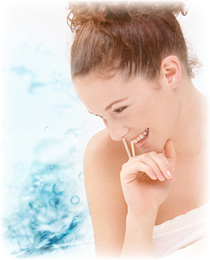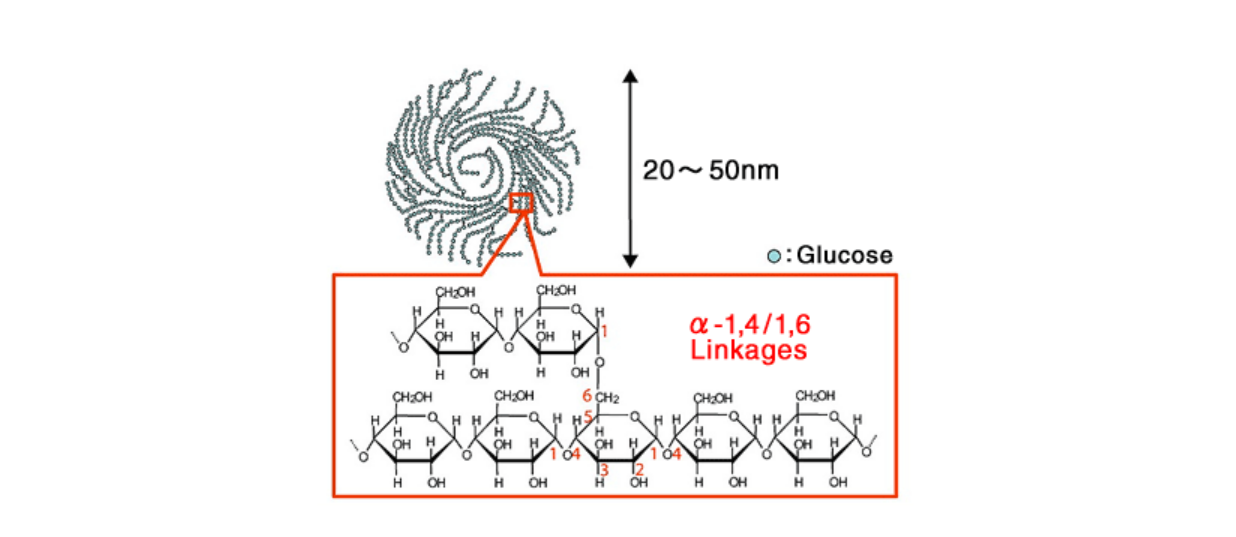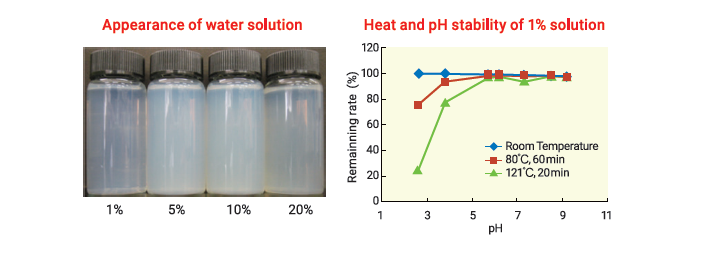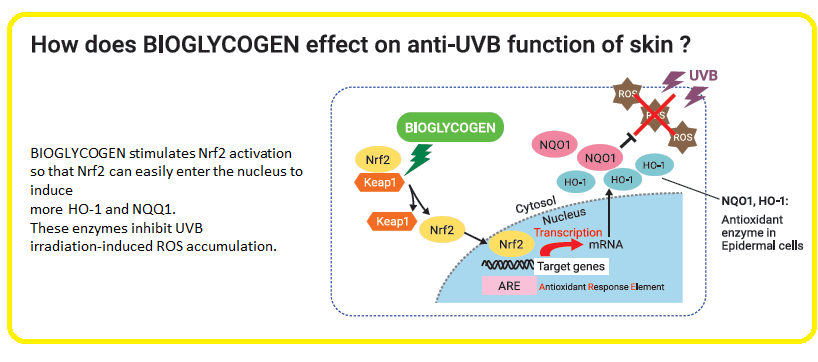BIOGLYCOGEN™ < Cosmetic Ingredient >
BIOGLYCOGEN
BIOGLYCOGEN is an enzymatically synthesized glycogen produced from corn starch by a sequential action using unique enzymes. BIOGLYCOGEN is used as an ingredient in cosmetics.
What is Glycogen?
Glycogen is a storage polysaccharide that occurs widely in nature, and is present in mussels, sweet corn, etc. Glycogen functions as an energy component in the human body and is stored in the skin and other tissues. According to our study (See figure below), the amount of glycogen in the skin decreases with age; therefore we consider that glycogen is an essential factor for the skin function.
(Method)
Human abdominal skin samples were solubilized in 30% KOH (100℃ for 30 minutes). Then, glycogen was collected from that solution by ethanol precipitation, hydrolyzed to glucose, and measured as a glucose equivalent.
Structure and Manufacturing Process
< Schematic model of glycogen structure >
< Synthetic method of BIOGLYCOGEN >
BIOGLYCOGEN is produced from corn starch with our originally developed enzymes.
Characteristics
- High water solubility (easily up to 20%) with an opalescent color in solution
- High stability (1% aqueous solution is stable at 80℃; pH > 3.8)
- Easily combines with other ingredients, except more than 10% alcohol, in cosmetic formulation
- Molecular weight, approximately 5,000 kDa
Anti-UV Effect
Mechanism of skin functions affected by BIOGLYCOGEN
Hypothesized mechanism forms in vitro studies,
BIOGLYCOGEN enhances NQO1 and HO-1 production for UVB protection and hyaluronan and ceramide production for moisturizing.
<in vitro>
1. BIOGLYCOGEN inhibits accumulation of reactive oxygen species (ROS) induced by UVB
(Method)
Normal human epidermal keratinocytes (NHEKs) were stimulated with BIOGLYCOGEN at a dosage of 400 or 600 μg/ml for 24 hours. Cells were then irradiated by UVB (20 mJ/cm2, 302 nm) and cultured for 30 minutes.
ROS accumulation levels were measured and relative accumulation levels are shown in the graph (means ± S.D.). Bars marked with different letters are significantly different from each other (p < 0.05, by the Tukey-Kramer).
BIOGLYCOGEN reduced ROS accumulation in a concentration-dependent manner.
2. BIOGLYCOGEN increases the expression of antioxidant-related proteins
(Method)
NHEKs were stimulated by BIOGLYCOGEN at a dosage of 300 or 600 mg/ml for 24 hours. Expression levels of antioxidant-related proteins (Nrf2, HO-1, and NQO1) in the cells were analyzed by western blot. Graphs show relative expression levels (means ± S.D.). Bars marked with different letters are significantly different from each other (p < 0.05, by the Tukey-Kramer).
BIOGLYCOGEN increased the expression of antioxidant-related proteins in a concentration-dependent manner.
| *1 Nrf2 (NF-E2-related factor 2): | Transcription regulatory factor that activates antioxidant response elements and induces HO-1, NQO1, and other genes. |
| *2 HO-1 (heme oxiygenase-1): | The enzyme that decomposes heme into biliverdin, CO and Fe3+. Biliverdin has a strong antioxidant property. |
| *3 NQO1 (NAD(P)H;quinone oxidoreductase): | TIt protects cells from quinone-induced ROS toxicity. |
3. Comparison of anti-UVB effect of BIOGLYCOGEN with native glycogens
(Method)
NHEKs were stimulated with BIOGLYCOGEN at a dosage of 600 μg/ml for 24 hours. Then, cells were irradiated by UVB (20 mJ/cm2, 302 nm) and cultured for 30 minutes.
The accumulation levels of ROS were measured and relative accumulation levels were shown in the graph (means ± S.D.).
Only BIOGLYCOGENs with a molecular weight of 3,000–7,000 kDa can suppress ROS accumulation, whereas native glycogens, such as those found in mussels and corn, do not exert this effect.
<in vivo >
4. Effect of BIOGLYCOGEN on skin condition
(Method)
- Study subject: 17 healthy volunteers
- Test sample: 0.5% BIOGLYCOGEN cream; Placebo cream
- Treatment: Applied twice a day (morning, night) for 1 month
- Design: Randomized placebo-controlled, double-blind study
- UV-irradiation: 1.2MED
- Evaluation: Erythema value
BIOGLYCOGEN suppresses UV irradiation-induced increase in erythema values.
Moisturizing Effect
<in vitro >
1. BIOGLYCOGEN enhances ATP and hyaluronan production
(Method)
NHEKs were stimulated by BIOGLYCOGEN at different concentrations and cultured for 24 hours. The concentrations of ATP in cells and hyaluronan in the culture supernatant were determined (*p < 0.05,***p < 0.001).
BIOGLYCOGEN enhanced ATP and hyaluronan production in NHEKs in a concentration-dependent manner (Fig. A, Fig. B).
A three-dimensional epidermal model was treated with BIOGLYCOGEN for 24 hours, and then frozen sections were prepared. Hyaluronan was fluorescently stained and observed by confocal laser scanning microscope (Fig. C).
2. BIOGLYCOGEN enhances ceramide production
(Method)
NHEKs were stimulated by BIOGLYCOGEN (2% w/v) for 7 days. Cellular lipids were then collected and analyzed by thin-layer chromatography. Each spot was quantitatively analyzed and is presented in the graph(Control, 2% BIOGLYCOGEN; n=5-7, p < 0.05).
BIOGLYCOGEN enhanced NHEK ceramides at 2% concentration.
<in vivo >
3. Effects of BIOGLYCOGEN on skin condition
(Method)
- Study subject: 20 healthy male and female aged between 45 and 59 years old who constantly felt lack of vitality and moisture in the skin
- Test sample: Lotion and cream including 1% BIOGLYCOGEN or Placebo
- Treatment: Applied on one side of face, Placebo on the other side twice a day for 1 month
- Evaluation: Skin condition
BIOGLYCOGEN improves skin conditions, such as hydration, wrinkles, and pores size.
Specifications
Specifications
For further information please contact us.
Name
| Trade name | BIOGLYCOGEN |
| INCI name | GLYCOGEN |
| Chinese INCI name | 糖原 |
Other Information
| CAS No. | 9005-79-2 |
| Certification | ISO 90001 |
Contact Us
| for enquiries, contact | Global Sales Department, Technical Sales Division, Glico Nutrition Co., Ltd. 4-6-5, Utajima, Nishiyodogawa-ku, Osaka 555-8502 Japan E-MAIL: g-ingredients@glico.com * When you contact us, please let us know your name, company and country in the message. |
















